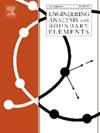Efficient surface reconstruction for SPH method and its application to simulation of solid-solid contact and fluid-rigid body interaction
IF 4.2
2区 工程技术
Q1 ENGINEERING, MULTIDISCIPLINARY
Engineering Analysis with Boundary Elements
Pub Date : 2025-02-01
DOI:10.1016/j.enganabound.2024.106086
引用次数: 0
Abstract
Explicit surface reconstruction is useful for treating challenging boundary-related problems in smoothed particle hydrodynamics (SPH), for example, high-accuracy contact treatment. In this work, an efficient local surface reconstruction method (LSRM) is proposed. It first identifies boundary layer particles and then employs the Delaunay triangulation technique to reconstruct explicit surfaces from the boundary layer particles. The surface reconstruction efficiency of the LSRM is examined by two-dimensional and three-dimensional test cases and compared with that of a global surface reconstruction method (GSRM) proposed previously. Compared with the GSRM, the LSRM shows an increasing advantage in efficiency as the number of particles increases, and its efficiency can be dozens of times higher when the number of particles is large. The LSRM is incorporated into SPH for contact treatment and is used to simulate some typical contact problems. The simulation results show that the LSRM is applicable to solid-solid contact problems involving friction and large deformation and fluid-rigid body interaction problems with complex free surface phenomena. Compared with the GSRM, the LSRM can produce simulation results with similar accuracy and significantly improve the overall efficiency of SPH simulation.
SPH方法的高效表面重构及其在固-固接触和流-刚体相互作用模拟中的应用
显式表面重构有助于处理平滑粒子流体力学(SPH)中具有挑战性的边界相关问题,例如高精度接触处理。本研究提出了一种高效的局部表面重构方法(LSRM)。它首先识别边界层粒子,然后采用 Delaunay 三角测量技术从边界层粒子重建显式表面。通过二维和三维测试案例检验了 LSRM 的表面重建效率,并与之前提出的全局表面重建方法(GSRM)进行了比较。与 GSRM 相比,LSRM 的效率随着粒子数量的增加而不断提高,当粒子数量较多时,其效率可提高数十倍。将 LSRM 纳入 SPH 进行接触处理,并用于模拟一些典型的接触问题。模拟结果表明,LSRM 适用于涉及摩擦和大变形的固-固接触问题,以及具有复杂自由表面现象的流-刚体相互作用问题。与 GSRM 相比,LSRM 可以得到精度相近的模拟结果,并显著提高 SPH 模拟的整体效率。
本文章由计算机程序翻译,如有差异,请以英文原文为准。
求助全文
约1分钟内获得全文
求助全文
来源期刊

Engineering Analysis with Boundary Elements
工程技术-工程:综合
CiteScore
5.50
自引率
18.20%
发文量
368
审稿时长
56 days
期刊介绍:
This journal is specifically dedicated to the dissemination of the latest developments of new engineering analysis techniques using boundary elements and other mesh reduction methods.
Boundary element (BEM) and mesh reduction methods (MRM) are very active areas of research with the techniques being applied to solve increasingly complex problems. The journal stresses the importance of these applications as well as their computational aspects, reliability and robustness.
The main criteria for publication will be the originality of the work being reported, its potential usefulness and applications of the methods to new fields.
In addition to regular issues, the journal publishes a series of special issues dealing with specific areas of current research.
The journal has, for many years, provided a channel of communication between academics and industrial researchers working in mesh reduction methods
Fields Covered:
• Boundary Element Methods (BEM)
• Mesh Reduction Methods (MRM)
• Meshless Methods
• Integral Equations
• Applications of BEM/MRM in Engineering
• Numerical Methods related to BEM/MRM
• Computational Techniques
• Combination of Different Methods
• Advanced Formulations.
 求助内容:
求助内容: 应助结果提醒方式:
应助结果提醒方式:


